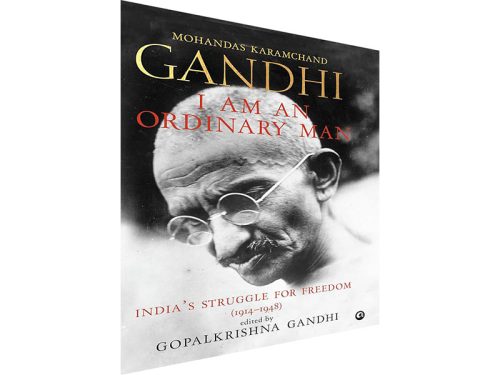Complex narrative
 Mohandas Karamchand Gandhi: I am an ordinary man — India’s struggle for freedom (1914-1948)
Mohandas Karamchand Gandhi: I am an ordinary man — India’s struggle for freedom (1914-1948)
Gopalkrishna Gandhi
Aleph Book Company
Rs.999
Pages 443
The dynamic flux of political, social and economic interventions together with Gandhiji’s relationships with hundreds of people demanded energies beyond the capacity of ordinary mortals
A reviewer assessing the sequel to Gopalkrishna Gandhi’s edited ‘autobiography’ of Mahatma Gandhi cannot but be poignantly struck by the unique experiment which was the freedom movement of India, and exceptional values which animated the initiatives taken by the remarkably talented group of leaders who helmed the movement.
The ethical energy and discernment which formed its core was of course embodied in the person of Mahatma Gandhi, who created and shaped the most original resistance strategy against colonial rule. Culled by his grandson from Gandhi’s own words as recorded in letters, or by his contemporaries or in the Collected Works of Mahatma Gandhi, this book offers a ringside view of the unfolding events, even as it connects with the day-to-day affairs of Gandhi’s immediate and extended family members and ashram associates.
The first volume covered, as suggested by the title, Gandhi’s early life and the years in South Africa until his decision to return home via London. This second volume attempts to thread together events encapsulating the decades from the beginning of World War I to his assassination on January 30, 1948. In terms of dwellings alone, these years witnessed establishment of ashrams at Kochrab and by the Sabarmati River in Ahmedabad, and others in Wardha and Sevagram near Nagpur.
In terms of Gandhi’s engagement with writing, they cover the inception and running of journals Young India, Navajivan and Harijan, besides authoring books including My Experiments with Truth, Satyagraha in South Africa, the interpretation of the Bhagwad Gita, prolific correspondence, speeches and many resolutions he was called upon to draft.
The span of major political interventions includes the Champaran Satyagraha; Ahmedabad mill workers Satyagraha; Bardoli Satyagraha; non-cooperation movement; Khilafat Movement; Salt Satyagraha; and the Quit India Movement. These movements meant imprisonment for long spells of time which, despite restrictions, gave Gandhi the solitude and time to catch up on reading and learning languages. His initiatives for social uplift cover the Khadi movement; Harijan Seva Sangh for eradication of untouchability and caste discrimination; the life-long struggle for Hindu-Muslim unity which culminated in the heroic one-man stand against mindless slaughter in the eastern States of Bengal and Bihar during the months before and after the Partition of the country, leading up to the final, tragic sacrifice in Delhi.
This dynamic flux of political, social, economic and spiritual interventions together with Gandhiji’s relationships with the several hundreds of people involved must have demanded energies beyond the capacity of ordinary mortals.
Moreover lodged at Yerawada Jail in solitary confinement in his very first jail term in India, Gandhiji caught up on his reading. The vast reading inventory comprising more than 150 books provides an indication of his formidable capacity to apply himself to tasks. Richly detailed, such a precise recording of the Mahatma’s life is invaluable.
It is at this point, however, that it becomes necessary to dwell upon the contrivances that the editor adopts to give his selected culling and stitching together of Gandhi’s pronouncements the semblance of a self-referential narrative. It is self-evident that the book can only reproduce what Gandhi has been recorded to have said: any extended meditation on a specific event quite clearly cannot be expected as it would be in an autobiographical narrative. Besides the fact that such expectations cannot be fulfilled is the additional disadvantage of having seemingly arbitrary events spliced together in a single chapter, given this is a chronological and linear narrative.
It is obvious that the connection between random events jostling together in a given chapter is because they have all taken place within a specific period of time. However, this jagged and rather haphazard recounting of events in a first person narrative is discomfiting.
Related to this is the question of autobiographical voice. While the words ascribed to the Mahatma may convey the tone, yet to have the autobiographical ‘I’ ascribe agency to itself in ordinary actions is to fluff the narrator into a rather narcissistic observer, jotting down details of his own responses and gestures.
Gandhi’s own autobiography Experiments is a case in point: quite clearly, the autobiographical ‘I’ there is far from narcissistic even as Gandhi is focused on himself and engaged in offering a true report of his activities. This remarkable achievement of the autobiographical mode is lacking in the grandson’s constructed ‘autobiography’.
Even as the significance of this stitched-together account of the Mahatma in his own words is undeniable given the present ethos, the artifice employed to give the impression of a life-narrative jars. In the bleak murkiness of our post-modern, post-truth times, one wishes the Mahatma, at least, had been spared this posthumous impression of artifice that the book confers on the narration.
Rohini Mokashi-Punekar (The Book Review)

















Add comment